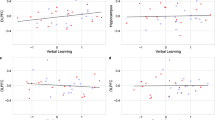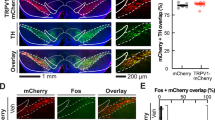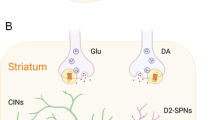Abstract
Positron emission tomography (PET) studies reveal that clozapine at clinically used doses occupies less than 60% of D2/D3 dopamine receptors in human striatum. Here, the occupancy of D2/D3 dopamine receptors by clozapine in patients with schizophrenia was determined to test the hypothesis that clozapine binds preferentially to extrastriatal dopamine receptors. A total of 15 clozapine-treated inpatients with schizophrenia underwent a [18F]fallypride PET scan. Receptor occupancy was calculated as percent reduction in binding potential relative to unblocked values measured in seven normal volunteers. Mean D2/D3 receptor occupancy was statistically significantly higher in cortical (inferior temporal cortex 55%) than in striatal regions (putamen 36%, caudate 43%, p<0.005). While the maximum attainable receptor occupancy Emax approached 100% both in the striatum and cortex, the plasma concentration at 50% of Emax (ED50) was much higher in the putamen (950 ng/ml) than in the inferior temporal cortex (333 ng/ml). Clozapine binds preferentially to cortical D2/D3 receptors over a wide range of plasma concentrations. This selectivity is lost at extremely high plasma levels. Occupancy of cortical receptors approaches 60% with plasma clozapine in the range 350–400 ng/ml, which corresponds to the threshold for antipsychotic efficacy of clozapine. Extrastriatal binding of clozapine may be more relevant to its antipsychotic actions than striatal. However, further studies with an intraindividual comparison of untreated vs treated state are desirable to confirm this finding.
Similar content being viewed by others
Log in or create a free account to read this content
Gain free access to this article, as well as selected content from this journal and more on nature.com
or
References
Bigliani V, Mulligan RS, Acton PD, Ohlsen RI, Pike VW, Ell PJ et al (2000). Striatal and temporal cortical D2/D3 receptor occupancy by olanzapine and sertindole in vivo: a [123I]epidepride single photon emission tomography (SPET) study. Psychopharmacology 150: 132–140.
Bressan RA, Erlandsson K, Jones HM, Mulligan RS, Ell PJ, Pilowsky LS (2003). Optimizing limbic selective D2/D3 receptor occupancy by risperidone: a [123I]-epidepride SPET study. J Clin Psychopharmacol 23: 5–14.
Brown RM, Crane AM, Goldman PS (1979). Regional distribution of monoamines in the cerebral cortex and subcortical structures of the rhesus monkey: concentrations and in vivo synthesis rates. Brain Res 168: 133–150.
Buchholz H-G, Siessmeier T, Landvogt C, Vernaleken I, Schirrmacher R, Schreckenberger M et al (2004). Stereotactic normalisation of BP images of D2-receptor ligand 18F-desmethoxyfallypride using ligand-specific template and SPM. Neuroimage 22(Suppl 2): T105.
Erlandsson K, Bressan RA, Mulligan RS, Ell PJ, Cunningham VJ, Pilowsky LS (2003). Analysis of D2 dopamine receptor occupancy with quantitative SPET using the high-affinity ligand [123I]epidepride: resolving conflicting findings. Neuroimage 19: 1205–1214.
Farde L, Nordström AL, Wiesel FA, Pauli S, Halldin C, Sedvall G (1992). Positron emission tomographic analysis of central D1 and D2 dopamine receptor occupancy in patients treated with classical neuroleptics and clozapine. Relation to extrapyramidal side effects. Arch Gen Psychiatry 49: 538–544.
Farde L, Wiesel FA, Hall H, Halldin C, Stone-Elander S, Sedvall G (1987). No D2 receptor increase in PET study of schizophrenia (letter). Arch Gen Psychiatry 44: 671–672.
Garris PA, Wightman RM (1994). Different kinetics govern dopaminergic transmission in the amygdala, prefrontal cortex, and striatum: an in vivo voltammetric study. J Neurosci 14: 442–450.
Gefvert O, Lundberg T, Wieselgren IM, Bergstrom M, Langstrom B, Wiesel F et al (2001). D(2) and 5HT(2A) receptor occupancy of different doses of quetiapine in schizophrenia: a PET study. Eur Neuropsychopharmacol 11: 105–110.
Goldsmith SK, Shapiro RM, Joyce JN (1997). Disrupted pattern of D2 dopamine receptors in the temporal lobe in schizophrenia. A postmortem study. Arch Gen Psychiatry 54: 649–658.
Gründer G, Carlsson A, Wong DF (2003a). Mechanism of new antipsychotic medications: occupancy is not just antagonism. Arch Gen Psychiatry 60: 974–977.
Gründer G, Siessmeier T, Piel M, Vernaleken I, Buchholz H-G, Zhou Y et al (2003b). Quantification of D2-like dopamine receptors in the human brain with [18F]desmethoxyfallypride. J Nucl Med 44: 109–116.
Gurevich EV, Bordelon Y, Shapiro RM, Arnold SE, Gur RE, Joyce JN (1997). Mesolimbic dopamine D3 receptors and use of antipsychotics in patients with schizophrenia. A postmortem study. Arch Gen Psychiatry 54: 225–232.
Halldin C, Farde L, Hogberg T, Mohell N, Hall H, Suhara T et al (1995). Carbon-11-FLB 457: a radioligand for extrastriatal D2 dopamine receptors. J Nucl Med 36: 1275–1281.
Hietala J, Syvalahti E, Vuorio K, Nagren K, Lehikoinen P, Ruotsalainen U et al (1994). Striatal D2 dopamine receptor characteristics in neuroleptic-naive schizophrenic patients studied with positron emission tomography. Arch Gen Psychiatry 51: 116–123.
Joyce JN (2001). D2 but not D3 receptors are elevated after 9 or 11 months chronic haloperidol treatment: influence of withdrawal period. Synapse 40: 137–144.
Kapur S, Zipursky R, Jones C, Remington G, Houle S (2000a). Relationship between dopamine D(2) occupancy, clinical response, and side effects: a double-blind PET study of first-episode schizophrenia. Am J Psychiatry 157: 514–520.
Kapur S, Zipursky R, Jones C, Shammi CS, Remington G, Seeman P (2000b). A positron emission tomography study of quetiapine in schizophrenia: a preliminary finding of an antipsychotic effect with only transiently high dopamine D2 receptor occupancy. Arch Gen Psychiatry 57: 553–559.
Kapur S, Zipursky RB, Remington G (1999). Clinical and theoretical implications of 5-HT2 and D2 receptor occupancy of clozapine, risperidone, and olanzapine in schizophrenia. Am J Psychiatry 156: 286–293.
Kessler RM, Ansari SM, Li R, Dawant B, Lee M, Meltzer HY (2002). Occupancy of striatal and extrastriatal dopamine D2 receptors by atypical antipsychotic drugs. J Nucl Med 43(Suppl): 15.
Kronig MH, Munne RA, Szymanski S, Safferman AZ, Pollack S, Cooper T et al (1995). Plasma clozapine levels and clinical response for treatment-refractory schizophrenic patients. Am J Psychiatry 152: 179–182.
Lammertsma AA, Hume SP (1996). Simplified reference tissue model for PET receptor studies. Neuroimage 4: 153–158.
Lidow MS, Elsworth JD, Goldman-Rakic PS (1997). Down-regulation of the D1 and D5 dopamine receptors in the primate prefrontal cortex by chronic treatment with antipsychotic drugs. J Pharmacol Exp Ther 281: 597–603.
Mukherjee J, Christian BT, Dunigan KA, Shi B, Narayanan TK, Satter M et al (2002). Brain imaging of 18F-fallypride in normal volunteers: blood analysis, distribution, test–retest studies, and preliminary assessment of sensitivity to aging effects on dopamine D-2/D-3 receptors. Synapse 46: 170–188.
Mukherjee J, Christian BT, Narayanan TK, Shi B, Mantil J (2001). Evaluation of dopamine D-2 receptor occupancy by clozapine, risperidone, and haloperidol in vivo in the rodent and nonhuman primate brain using 18F-fallypride. Neuropsychopharmacology 25: 476–488.
Mukherjee J, Yang ZY, Das MK, Brown T (1995). Fluorinated benzamide neuroleptics—III. Development of (S)-N-[(1-allyl-2-pyrrolidinyl)methyl]-5-(3-[18F]fluoropropyl)-2, 3-dimethoxybenzamide as an improved dopamine D-2 receptor tracer. Nucl Med Biol 22: 283–296.
Nordström AL, Farde L, Nyberg S, Karlsson P, Halldin C, Sedvall G (1995). D1, D2, and 5-HT2 receptor occupancy in relation to clozapine serum concentration: a PET study of schizophrenic patients. Am J Psychiatry 152: 1444–1449.
Olsson H, Farde L (2001). Potentials and pitfalls using high affinity radioligands in PET and SPET determinations on regional drug induced D2 receptor occupancy—a simulation study based on experimental data. Neuroimage 14: 936–945.
Olsson H, Halldin C, Farde L (2004). Differentiation of extrastriatal dopamine D2 receptor density and affinity in the human brain using PET. Neuroimage 22: 794–803.
Pehek EA (1999). Comparison of effects of haloperidol administration on amphetamine-stimulated dopamine release in the rat medial prefrontal cortex and dorsal striatum. J Pharmacol Exp Ther 289: 14–23.
Perry PJ, Miller DD, Arndt SV, Cadoret RJ (1991). Clozapine and norclozapine plasma concentrations and clinical response of treatment-refractory schizophrenic patients. Am J Psychiatry 148: 231–235.
Pilowsky LS, Mulligan RS, Acton PD, Ell PJ, Costa DC, Kerwin RW (1997). Limbic selectivity of clozapine. Lancet 350: 490–491.
Potkin SG, Bera R, Gulasekaram B, Costa J, Hayes S, Jin Y et al (1994). Plasma clozapine concentrations predict clinical response in treatment-resistant schizophrenia. J Clin Psychiatry 55(Suppl B): 133–136.
Riva MA, Tascedda F, Lovati E, Racagni G (1997). Regulation of NMDA receptor subunit messenger RNA levels in the rat brain following acute and chronic exposure to antipsychotic drugs. Brain Res Mol Brain Res 50: 136–142.
Seeman P (2002). Atypical antipsychotics: mechanism of action. Can J Psychiatry 47: 27–38.
Siessmeier T, Zhou Y, Buchholz H-G, Landvogt C, Vernaleken I, Piel M et al (2005). Comparison of parametric methods for the analysis of PET studies with D2 receptor ligands of different affinities. J Nucl Med 46: 964–972.
Suhara T, Okauchi T, Sudo Y, Takano A, Kawabe K, Maeda J et al (2002a). Clozapine can induce high dopamine D(2) receptor occupancy in vivo. Psychopharmacology (Berl) 160: 107–112.
Suhara T, Okubo Y, Yasuno F, Sudo Y, Inoue M, Ichimiya T et al (2002b). Decreased dopamine D2 receptor binding in the anterior cingulate cortex in schizophrenia. Arch Gen Psychiatry 59: 25–30.
Takano A, Suhara T, Ikoma Y, Yasuno F, Maeda J, Ichimiya T et al (2004). Estimation of the time-course of dopamine D2 receptor occupancy in living human brain from plasma pharmacokinetics of antipsychotics. Int J Neuropsychopharmacol 7: 19–26.
Talvik M, Nordström AL, Nyberg S, Olsson H, Halldin C, Farde L (2001). No support for regional selectivity in clozapine-treated patients: a PET study with [(11)C]raclopride and [(11)C]FLB 457. Am J Psychiatry 158: 926–930.
Talvik M, Nordstrom AL, Olsson H, Halldin C, Farde L (2003). Decreased thalamic D2/D3 receptor binding in drug-naive patients with schizophrenia: a PET study with [11C]FLB 457. Int J Neuropsychopharmacol 6: 361–370.
Tuppurainen H, Kuikka J, Viinamaki H, Husso-Saastamoinen M, Bergstrom K, Tiihonen J (2003). Extrastriatal dopamine D 2/3 receptor density and distribution in drug-naive schizophrenic patients. Mol Psychiatry 8: 453–455.
Vernaleken I, Siessmeier T, Buchholz H-G, Härtter S, Hiemke C, Stoeter P et al (2004). High striatal occupancy of D2-like dopamine receptors by amisulpride in brain of patients with schizophrenia. Int J Neuropsychopharmacol 7: 421–430.
Weigmann H, Härtter S, Mehrlein S, Kiefer W, Krämer G, Dannhardt G et al (2001). Simultaneous determination of olanzapine, clozapine and demethylated metabolites in serum by on-line column-switching high performance liquid chromatography. J Chromatogr B Sci 759: 63–71.
Xiberas X, Martinot JL, Mallet L, Artiges E, Canal M, Loc'h C et al (2001). In vivo extrastriatal and striatal D2 dopamine receptor blockade by amisulpride in schizophrenia. J Clin Psychopharmacol 21: 207–214.
Yasuno F, Suhara T, Okubo Y, Sudo Y, Inoue M, Ichimiya T et al (2004). Low dopamine d(2) receptor binding in subregions of the thalamus in schizophrenia. Am J Psychiatry 161: 1016–1022.
Acknowledgements
We thank Sabine Höhnemann and Markus Piel for performing the syntheses of [18F]fallypride, and Heike Armbrust for assistance in performing the PET studies. We gratefully acknowledge Martina Klein's and Carsten Eulitz' statistical advice. Parts of this work are included in Jasmin Ondracek's doctoral thesis at the Medical Faculty of the University of Mainz. This study was supported by the University of Mainz (MAIFOR program), the Research Fund of the University of Mainz, the State Rheinland-Pfalz, and the German Research Council (DFG, grant Ba 1101/2-1).
Author information
Authors and Affiliations
Corresponding author
Additional information
Part of this work was presented at the 42nd Meeting of the American College of Neuropsychopharmacolgy (ACNP), December 7–11, 2003, San Juan, Puerto Rico
Financial disclosure
Dr Gründer has served as a consultant for Bristol-Myers Squibb (New York, NY), Otsuka (Rockville, MD), Pfizer (New York, NY), and Astra Zeneca (London, UK). He has served on the speakers' bureau of Bristol-Myers Squibb, Otsuka, Pfizer, Astra Zeneca, and Eli Lilly (Indianapolis, IN). He has received grant support from Bristol-Myers Squibb, Pfizer, and Sanofi Synthélabo (Paris, France). Dr Wong has served as a consultant for Bristol-Myers Squibb, Lilly and Abbott Labs (Chicago, IL). He has received grant support from Aventis (Strasbourg, France), Janssen (Beerse, Belgium), Eli Lilly, Pfizer, and Sumitomo (Osaka, Japan).
Rights and permissions
About this article
Cite this article
Gründer, G., Landvogt, C., Vernaleken, I. et al. The Striatal and Extrastriatal D2/D3 Receptor-Binding Profile of Clozapine in Patients with Schizophrenia. Neuropsychopharmacol 31, 1027–1035 (2006). https://doi.org/10.1038/sj.npp.1300931
Received:
Revised:
Accepted:
Published:
Issue date:
DOI: https://doi.org/10.1038/sj.npp.1300931
Keywords
This article is cited by
-
The relationship between excitement symptom severity and extrastriatal dopamine D2/3 receptor availability in patients with schizophrenia: a high-resolution PET study with [18F]fallypride
European Archives of Psychiatry and Clinical Neuroscience (2018)
-
Update on the Mechanism of Action of Aripiprazole: Translational Insights into Antipsychotic Strategies Beyond Dopamine Receptor Antagonism
CNS Drugs (2015)
-
ITI-007 demonstrates brain occupancy at serotonin 5-HT2A and dopamine D2 receptors and serotonin transporters using positron emission tomography in healthy volunteers
Psychopharmacology (2015)
-
Determination of dopamine D2 receptor occupancy by lurasidone using positron emission tomography in healthy male subjects
Psychopharmacology (2013)
-
Striatal and extrastriatal dopamine D2 receptor occupancy by the partial agonist antipsychotic drug aripiprazole in the human brain: a positron emission tomography study with [11C]raclopride and [11C]FLB457
Psychopharmacology (2012)



